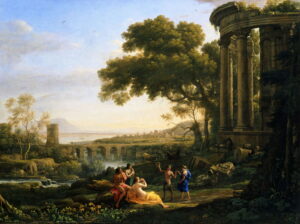Heroines 12: The many faces of Medea

There are some mythological subjects that artists would do best to avoid, while others almost guarantee success. Medea, sorceress and jilted wife of Jason of Golden Fleece fame, is clearly one of the former. For a start, there’s no single authoritative account of the myths of Jason and Medea. The ancients had no problem in living with conflicting tales, as in their day so little in life could be proved in any rigorous way. But since the Age of Enlightenment we have looked at the world in the expectation of singular truths. In Medea’s case, there isn’t even a rough consensus.
One broad outline might be that Jason travelled to Colchis, where he underwent a series of trials imposed by King Aeëtes, culminating in Jason’s victory over the dragon guarding the Golden Fleece. These were accomplished with the help of Medea, the King’s daughter, in return for Jason’s promise of marriage.
During their voyage home, Medea and Jason married, and she then bore him two sons. Ten years later, Jason divorced Medea in favour of the King of Corinth’s daughter Glauce. Divorce was too much for Medea to bear, so she sent Glauce a poisoned wedding dress to kill her and her father horribly. She then murdered her two children, fled to Athens, and had a child by King Aegeus.
The most consistent insight that we have into Medea is of the depth and complexity of her role and character, particularly in comparison with Jason, a simple pop-up action hero whose endless stream of testosterone made thought largely unnecessary. Yet Medea’s fascinating combination of conflicting roles – princess, sorceress, seductress, wife, mother, and vengeful filicide – have only brought trouble to the succession of painters who have tried to portray her.
Paulus Bor (c 1601–1669), The Disillusioned Medea (The Enchantress) (c 1640), oil on canvas, 155.6 x 112.4 cm, The Metropolitan Museum of Art, New York, NY. Wikimedia Commons.
From the Renaissance on, paintings of the adventures of Jason and the Argonauts have been frequent and popular. It fell to the obscure Dutch artist Paulus Bor to tackle The Disillusioned Medea (The Enchantress) in about 1640. Believed to have formed a pair with his painting of Cydippe with Acontius’s Apple, Bor comes closest to capturing Medea’s intriguing psychology.
She sits, her face flushed, resting her head on the heel of her right hand. In her left, she holds a wand made from bamboo or rattan, a reference to her sorcery. Her wand is poised ready for use as soon as she has worked out what to do next. Behind her is a small altar to Diana, the goddess of contradiction (the hunt and nature, chastity and childbirth) and the irrational (the moon and nature).
Paired with the story of Acontius and Cydippe, Bor can only be referring to Ovid’s fictional letter from Medea to Jason, letter twelve in his Heroides. Jason has told Medea of their divorce, but she hasn’t yet murdered their children. Medea gives a potted summary of their relationship, her crucial role in Jason’s quest for the Golden Fleece, and how she had turned her loyalties to him and betrayed her own family. Ovid ends it with portentous lines about Medea following her wrath, and of great forces acting on her soul.
There is another tragedy here too: although almost all of Ovid’s known works have survived to the present, one which hasn’t is his Medea, where his account of her role might have redressed the balance with accounts of Jason’s deeds.
After Bor’s painting, there is a gap of almost two centuries before the next substantial attempt to depict Medea at this troubled time.
Joseph Mallord William Turner (1775–1851), Vision of Medea (1828), oil on canvas, 173.7 x 248.9 cm, The Tate Gallery (Accepted by the nation as part of the Turner Bequest 1856), London. Image © and courtesy of The Tate Gallery, http://www.tate.org.uk/art/artworks/turner-vision-of-medea-n00513
JMW Turner’s Vision of Medea (1828) is the first in a series of more modern attempts to tell Medea’s story, and one of Turner’s few uses (perhaps his only use) of multiplex narrative. Turner had stayed in Rome with Sir Charles Eastlake during the autumn and winter of 1828, where he painted his View of Orvieto, Regulus, and this work, together with several other paintings whose identity is less certain.
He exhibited them there to the outrage of critics and the puzzlement of the public. Turner didn’t show this painting at the Royal Academy until 1831, where it was considered to be a wonderful “combination of colour”, but generally incomprehensible.
In the middle of the canvas, Medea is stood in the midst of her incantation to force Jason’s return. In the foreground are the materials she is using to cast her spell: flowers, snakes, and other supplies of a sorceress. Seated by her are the Fates. In the upper right, Medea is shown again in a flash-forward to her fleeing Corinth in a chariot drawn by dragons, the bodies of her children thrown down after their deaths.
Gustave Moreau (1826–1898), Jason (1865), oil on canvas, 204 × 115 cm, Musée d’Orsay, Paris. Wikimedia Commons.
Next was Gustave Moreau, in his Jason (1865), which bizarrely excludes Medea from its title. She stands almost naked behind Jason, holding a vial in her right hand, and her body is swathed with the poisonous hellebore plant, a standard tool of witchcraft. It has been suggested that these allude to Jason’s future rejection of Medea and her poisoning of Glauce, but that isn’t borne out by the only clues that Moreau provides, in the almost illegible inscriptions on the two phylacteries wound around the column.
Translated from their Latin, these read: Nay, holding that which I love, and resting in Jason’s arms, I shall travel over the long reaches of the sea; in his safe embrace I will fear nothing. And the heroic son of Aeson [i.e. Jason] gained the Golden Fleece. Proud of this spoil and bearing with him the giver of his prize, another spoil.
These imply we should read the painting in terms of the conflict between Jason and Medea: Medea expresses her subjugate trust in him, while Jason considers her to be just another spoil won alongside the Golden Fleece. When exhibited at the Salon in 1865, the critics were unsure of what they were supposed to be looking at, and Moreau’s narrative was lost amid his surfeit of symbols.
Frederick Sandys (1829–1904), Medea (1866-68), oil on wood panel with gilded background, 61.2 x 45.6 cm, Birmingham Museum and Art Gallery, Birmingham England. Wikimedia Commons.
A few years later, Frederick Sandys tried his Medea (1866-68), now possibly his best-known painting. He shows Medea at work preparing a magic potion for one of Jason’s missions. In front of her is a pair of toads copulating, and other ingredients. Behind her, in a gilt frieze, is Jason’s ship the Argo. Despite this fine depiction and Medea’s intense stare, this painting was rejected by the Royal Academy in 1868.
Anselm Feuerbach (1829–1880), Medea (1870), oil on canvas, 198 × 396 cm, Neue Pinakothek, Munich, Germany. Wikimedia Commons.
While Sandys was still smarting from that blow, Anselm Feuerbach was painting Medea (1870) as a mother of two, watching as Jason and his Argonauts push their boat back into the surf to go in quest of the Golden Fleece. She is shown as an archetypal mother, a Madonna and infant plus one, not even looking at the departing boat. She is no sorceress, and the merest suggestion that she could ever kill those children in vengeance seems absurd.
Evelyn De Morgan (1855–1919), Medea (1886), oil on canvas, 148 x 88 cm, Williamson Art Gallery & Museum, Birkenhead, England. The Athenaeum.
Evelyn De Morgan’s Medea (1886) is visually rich but narratively thin. She has been abandoned by Jason, and now stares wistfully as she walks along the polished stone floor of her palace holding a vial of potion in her right hand: might this be the substance with which she impregnated the wedding dress she sent Glauce?
John William Waterhouse (1849–1917), Jason and Medea (1907), oil on canvas, 131.4 x 105.4 cm, Private collection. Wikimedia Commons.
My final example comes from John William Waterhouse in his Jason and Medea (1907). Medea is depicted as a sorceress, perhaps preparing the potion Jason is to later give to the dragon. He appears anxious, ready to go and tackle his challenge. Unlike Sandys, Waterhouse paints but a single toad, behaving itself quietly on the floor.
Each of these paintings has captured some of the many facets of Medea and her complex story. None comes close to the nuances of the verbal accounts, and in their efforts to approach this subject, painters have taken risks that haven’t paid off, at least at the time. Sandys was done an injustice when his painting was rejected by the Royal Academy, and that and Bor’s appear now to be her most successful portraits.

